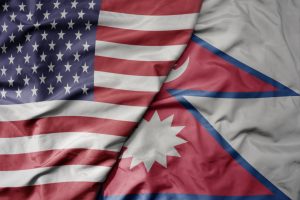On August 30, the U.S. Millennium Challenge Corporation (MCC) and the government of Nepal held a quiet joint ceremony to start the clock on the implementation of MCC projects in Nepal. The once controversial U.S. program has largely slipped from the public’s eye in the years following its ratification by the Nepali Parliament.
Although little more than an afterthought for some, and a regrettable fait accompli for others, the streets of Kathmandu still bear witness to the fierce opposition to the MCC, which brought thousands into the streets to express frustration at their government’s decision to accept the U.S. grant. Anti-American graffiti still adorns the occasional wall. And now that the dust is once again unsettled – this time literally, as construction begins – it might be time to look at some key lessons for understanding and handling international deals amid growing geopolitical tension.
The MCC was created by U.S. legislation in 2004 to provide “independent” foreign aid outside the purview of USAID, as well as the departments of state and treasury. According to its website, the MCC is actively operating in 22 countries, including six in the Asia-Pacific: Nepal with a $500 million grant, Solomon Islands ($20 million), Mongolia ($350 million), Indonesia ($649 million), Kiribati ($29 million), and Timor-Leste ($420 million). Additional funding is provided by the recipient countries; in Nepal’s case an extra $197 million was contributed to the projects.
According to the official description from the MCC, the compact with Nepal “aims to maintain road quality, increase the availability and reliability of electricity, and facilitate cross-border electricity trade between Nepal and India.” So why did this half-a-billion-dollar grant become so controversial?
Despite pledges “to insulate the funds from U.S. strategic foreign policy,” MCC grants are, in some quarters – both inside and outside Nepal’s Parliament – viewed as U.S. interference, even as a lurking form of U.S. imperialism.
Independent Kathmandu-based journalist Tanka Dhakal, explained that many people saw the MCC program as opening the door to U.S. influence at the expense of Nepal’s national interest. Political parties capitalized on the uncertainty of the process and stoked “nationalist politics to gain power by using MCC, whether by supporting or opposing [it].”
Tensions between China and the United States, and between India and China, have imbued many development projects with suspicions, and the furor over the Nepali MCC grant is no different. In Nepal, one opposing argument that never truly went away was that, despite what the Americans officially said, the MCC was in fact a piece in the Indo-Pacific Strategy (IPS) architecture designed to check China. In that light, the MCC grant was viewed as a U.S. counterweight to the Chinese Belt and Road Initiative that would needlessly further embroil Nepal in power politics – the same dilemma Nepal has over its history tried so hard to avoid with its non-aligned foreign policy and its membership in the Non-Aligned Movement before that.
U.S. officials have not been particularly successful in assuaging these suspicions either, with some top U.S. diplomats publicly casting doubt on whether MCC is indeed insulated from U.S. foreign policy, in particular the contentious IPS. Furthermore, in 2022, the U.S. Nepal Embassy had to walk back comments from Donald Lu, the assistant secretary of state for South and Central Asia, who is reported to have said that “if Nepali political leadership failed to endorse the MCC compact grant within the stipulated deadline of February 28, the U.S. would be forced to review its ties with Nepal.”
In contrast to the heated debate and protests that surrounded its passage, the implementation of the MCC has seen far less attention. With a formal deadline of no more than five years to complete the projects, the Millennium Challenge Account Nepal – the overseeing authority – is keen to get started. And already the acquisition process has begun in the district southwest of Kathmandu. A look into the experience of similar projects in Nepal makes clear that the implementation phase, especially land acquisition, will face resistance and delays; being so highly politicized already, the initial progress of the MCC will likely be protracted.
Notwithstanding the bureaucratic and logistical practicalities of implementing large-scale road and high voltage powerline projects, on a political level there surely must be a lot to reflect on in Washington, with such fierce public backlash as well as geopolitical pushback.
When I put that to a MCC spokesperson, they said Nepal was among their “largest and most challenging compacts.” For the MCC, the Nepal Compact brought home the need to stay on message and to ensure the grant was widely understood.
As the MCC assesses candidates for fiscal year 2024, looking into countries like Samoa, Vanuatu, Yemen, Chad, and Bangladesh, it remains to be seen how the MCC will apply hard-won lessons from Nepal about how to manage the diplomatic strife that has dogged this program.

































